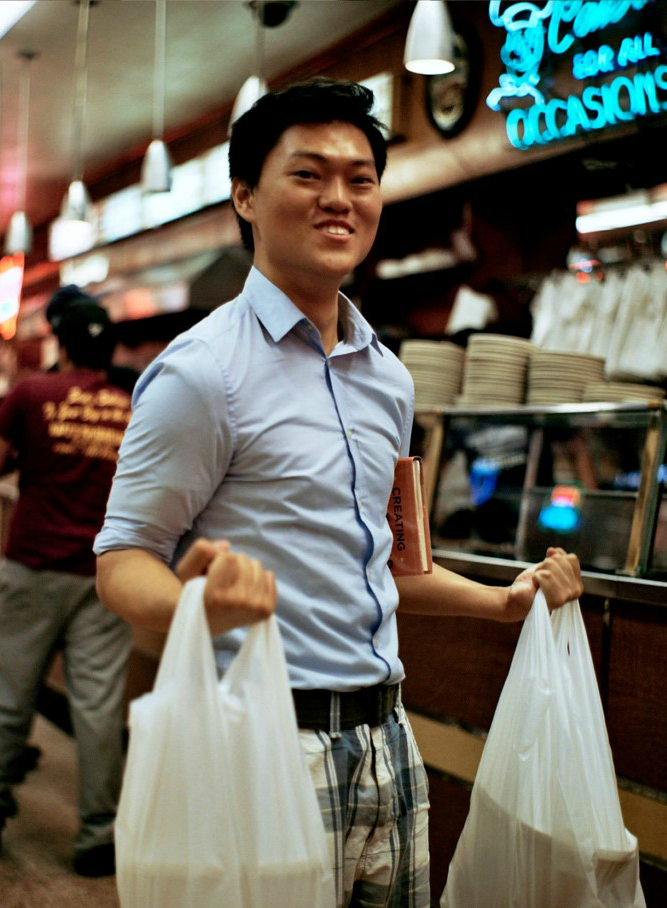
By: Leslie Koren
Like so many New Yorkers, Viola Bowe orders groceries online. Every Wednesday, she puts milk, fruit, veggies, rice and beans into a virtual cart — quite an improvement, she says, from her previous experience with the city’s emergency food pantries.
Before the New York Common Pantry (NYCP) website became operational, “on line” meant something else entirely for Bowe and her son — a lot of waiting. “In heat like this,” she said on a recent 90-degree day, “sometimes I wouldn’t even go.”
Getting food to the hungry is an important part of Robin Hood’s mission, not only because the organization believes no New Yorker should have to live with an empty belly — one in six are food insecure — but also because emergency food relief is a front door to other poverty-fighting benefits and services. For a long time, food-provider programs have been essentially no-frills. Now, however, several programs are incorporating technology to improve customer service, expand choice, minimize waste and optimize volunteer efforts.

“There’s efficiency — the most people getting the most food in a smart way,” says Amanda Stern, Robin Hood’s program officer for Income Security and Survival. “Just as important, it infuses dignity into the process.”
In fact, it takes Bowe about two minutes to pick up the food she ordered online the night before. “This is much easier,” she says, finding her order on a shelf at the East Harlem outpost.
The organization transitioned to its digital system five years ago, to offer greater choice to its more than 300,000 annual visitors. Before the move, volunteers simply packed the same items for everyone based on family size. Now 10 percent of customers order online, while others use on-site tablets to scroll through options in each of five MyPlate food groups. The menu, translatable into Chinese and Spanish in addition to English, includes pictures of each item to combat literacy challenges. Once a list is submitted, a ticket is printed in the packing room, where volunteers immediately fulfill the order. Time from log on to ready-for-pick-up is about 15–20 minutes.
Across the river in Brooklyn, at the Robin Hood-funded St. John’s Bread and Life, the story is similar. First-time user Kashla Langellier steps up to the computer station to enter an order, which to her delight can include almond milk. While volunteers pack her selections, she does exactly what Robin Hood’s program team hopes she would: she heads upstairs to talk with case workers, first from the Robin Hood’s Single Stop program about benefit options, then from St. John’s itself about a summer job for her younger sister. “We only fund emergency food organizations with infrastructures that can load you up with services,” Stern says.
Because Bread and Life’s pantry system is tied into its case-management system, the network cross-references data to identify when a user requires a specific diet — low sodium, Kosher or even microwaveable for those who live in facilities with limited kitchen access — and edit selections accordingly.

The data-centric approach adds efficiency to the business end of the operation, as well. “It gives us a real value of our inventory and a real picture of our food costs,” says Executive Director Anthony Butler. This was especially helpful in the aftermath of Hurricane Sandy, enabling Bread and Life to know which items were in short supply.
A clearer accounting of inventory reduces food waste, since doling out what people actually want means fewer leftovers at home. NYCP Deputy Executive Director Daniel Reyes recalls one man who sheepishly returned an armload of peanut butter jars. He didn’t want to seem ungrateful, but he couldn’t bear the taste.
Perhaps more importantly, the digital systems have increased convenience for the families who make use of the pantries, particularly those with jobs and childcare issues that complicate their schedules. At Bread and Life, a customer can place an order early in the morning and retrieve it at the end of the day.
 Technology benefits homeless shelters, too. Every night, volunteers at Rescuing Leftover Cuisine a venture spawned by Robin Hood’s Blue Ridge Labs — pick up unused food from restaurants, hotels and catering companies and deliver it to nearby shelters. The process is automated via a website and soon with a mobile app. Last year the group’s three full-time employees rescued more than 287,000 pounds of food. As a bonus, Rescuing Leftover Cuisine provides participating restaurants with monthly food waste reports.
Technology benefits homeless shelters, too. Every night, volunteers at Rescuing Leftover Cuisine a venture spawned by Robin Hood’s Blue Ridge Labs — pick up unused food from restaurants, hotels and catering companies and deliver it to nearby shelters. The process is automated via a website and soon with a mobile app. Last year the group’s three full-time employees rescued more than 287,000 pounds of food. As a bonus, Rescuing Leftover Cuisine provides participating restaurants with monthly food waste reports.
“Every restaurant in the world has leftover food that is going to be thrown out. Every night we go and pick some of it up,” says co-founder Robert Lee. “Through technology, we’ve engaged the public to get involved in the fight against hunger on their way home from work.”